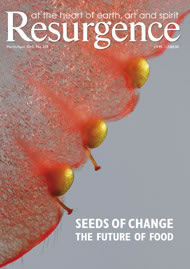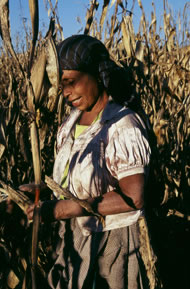Cheap food causes hunger.
On its face, the statement makes no sense. If food is cheaper it’s more affordable and more people should be able to get an adequate diet. That is true for people who buy food, such as those living in cities. But it is quite obviously not true if you’re the one growing the food. You’re getting less for your crops, less for your work, less for your family to live on. That is as true for Vermont dairy farmers as it is for rice farmers in the Philippines. Dairy farmers today are getting prices for their milk that are well below their costs of production. They are putting less food on their own tables. And they are going out of business at an alarming rate. When the economic dust settles, this will leave us with fewer family farmers producing the dairy products most of us depend on.
This is the central contradiction of cheap food. Low agricultural prices cause hunger in the short term among farmers. And they cause food insecurity in the long term because they reduce both the number of farmers and the money they have to invest in producing more food.
An estimated 70% of the world’s poor live in rural areas and depend either directly or indirectly on agriculture. Cheap food has made them hungry and kept them in poverty. It has also starved the countryside in the developing world of much-needed agricultural investment. Farmers have nothing to invest if they are losing money on their crops.
The food crisis has indeed served as a wake-up call for governments and international agencies responsible for such matters. Among those most shaken from their policy slumber were officials at the World Bank, which cut the share of its spending on agricultural development from 30% in 1980 to just 6% in 2006. But, lo and behold, the World Bank’s World Development Report for 2008 carried the subtitle Agriculture for Development. It was the first time in twenty-five years that the Bank had focused its signature publication on agriculture. The renewed attention was welcome, as it included a call to reinvest in smallholder agriculture, not just large-scale export crops.
The Bank, of course, studiously avoided taking any responsibility for having promoted the very policies that caused agriculture to be neglected in the first place: not only the cuts in aid and investment, but the structural adjustment programmes, imposed as conditions on its loans, which gutted the capacity of most governments to support domestic agriculture.
These same structural adjustment programmes were part of the campaign to get governments out of the economy altogether. The argument was that the market should be allowed to work its magic, to allocate resources more efficiently, to set prices without government distortions. Trade policy needed to reduce the government role as well, cutting protective tariffs and quotas and price supports, following the theory of comparative advantage.
In agriculture, what that meant for developing countries was that if you couldn’t produce basic grains as efficiently – read ‘cheaply’ – as they could in the US, or Australia, or Brazil, you just shouldn’t produce basic grains. It would be cheaper – “more efficient” – to buy them on the international market. Instead, maybe you should produce, say, flowers for export, or winter strawberries for the US market. But maybe you shouldn’t produce anything because maybe your land is bad and you have no roads to get produce to a port anyway. So maybe there’s nothing the market wants from you. And it doesn’t need your home-grown grains any more because they are being imported.
That’s really how the theory works. The idea is that a country can import all the food it needs, and it should do so if it can get that food more cheaply from abroad than it could by having its own farmers grow it. One obvious problem with this approach is that if farmers stop growing food, their families don’t have anything to eat, and if they can’t get jobs, they have no money to buy food.
Secondly, a country can end up in a situation of food dependency, which becomes particularly problematic when prices spike and supplies get tight. That is what we saw recently with what became known as the food crisis. Countries like the Philippines couldn’t get the rice they needed. They had stopped producing enough rice to protect themselves from such a market shock, and they couldn’t get anyone to sell it to them because governments were concerned about feeding their own people first.
This exposed the dangers of following policies that say you can get all the cheap food you need out in the international market. A lot of countries have taken note of that; the Philippines is now on a multi-year national campaign to restore self-sufficiency in rice production.
One place where the government seems to have kept its ideological blinkers firmly in place is Mexico. There, in the birthplace of corn, where the crop was domesticated into one of the world’s most important food crops, there were tortilla riots in the streets as people couldn’t afford this most basic staple. In the fifteen years since the North American Free Trade Agreement took effect, US corn has flooded Mexico at prices half what it cost to produce in Mexico. Mexico now depends on imports from the US for more than a third of its corn. Some two million hungry farmers have left agriculture under the flood of cheap food.
The food crisis also illustrates what some have called the globalisation of market failure. Globalisation involves opening markets and bringing things that are produced in different parts of the world into direct competition. The assumption – and the integrity of the economic theory hinges on such assumptions – is that those markets work; that prices actually reflect the real values of what’s being traded. In agriculture, the assumption is that efficiency equals high yield, which means low price, which reflects the actual value of what’s produced. When it doesn’t, economists call it a market failure. Agriculture is rife with market failures. You can see it in the Mexico-US trade in corn.
Environmental costs are one of the key areas where the market fails to adequately value both costs and benefits. The US specialises in environmental costs. Corn is one of the most polluting US crops of all. Excessive water and chemical use, run-off of fertilisers into waterways, the dead zone at the mouth of the Mississippi River in the Gulf of Mexico: all are examples of high environmental costs from US corn production. Producers and traders pay virtually none of the costs of those damages, and the price of corn when it goes across the border into Mexico does not reflect these environmental costs.
What happens on the Mexican side? Well, the smaller producers are maintaining great biodiversity – both wild and in corn varieties – with low-input systems. These positive contributions go unrewarded by the market. Corn biodiversity has virtually no value in the global marketplace, yet these corn seeds are the building block for future varieties of corn: ones we will need to withstand climate change, deal with pesticide resistance, and so on. The price of Mexican corn does not reflect these contributions to the common good.
When you globalise trade, you also globalise market failure. You get under-priced US corn coming into direct competition with under-valued Mexican corn. Mexican corn loses that competition, but not because it’s less ‘efficient’. A Mexican farmer once said, “We’ve been producing corn in Mexico for 8,000 years. If we don’t have a comparative advantage in corn, where do we have a comparative advantage?” He’s right. The problem is that comparative advantage as defined by the global marketplace doesn’t value the advantage that Mexican corn offers. And in the deregulated marketplace, the only value is how cheap something is.
The globalisation of market failure gives us a worsening environment, increasing poverty among food producers, increasing food dependence, and hunger. That is why one of the main culprits of the food crisis is our blind pursuit of cheap food.
Globalisation cheapens everything. The problem is that some things just shouldn’t be cheapened. The market is very good at establishing the value of many things but it is not a good substitute for human values. Societies need to determine their own human values, not let the market do it for them. There are some essential things, such as our land and the life-sustaining foods it can produce, that should not be cheapened.








